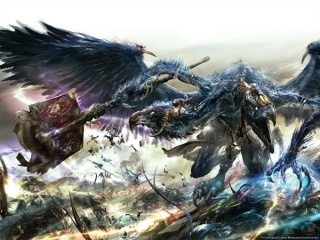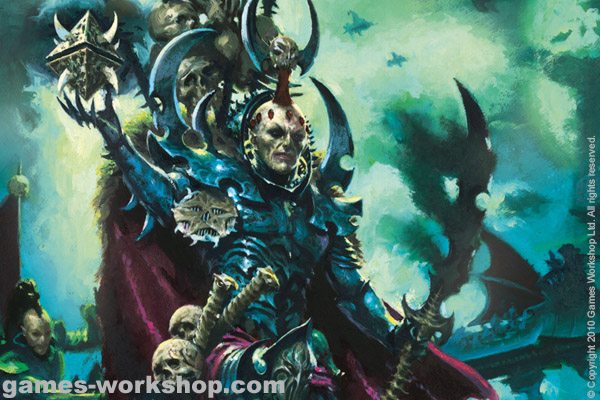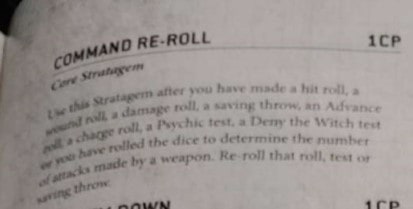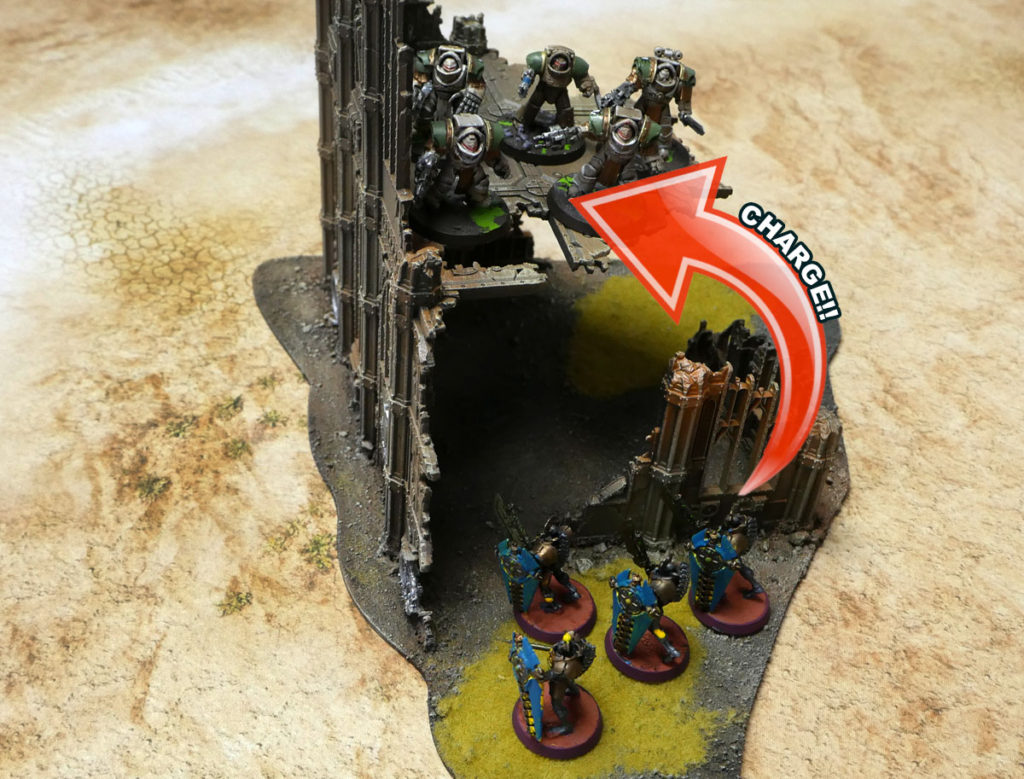A lot of things had some big shifts in the new edition, but one of the biggest changes was also the smallest change- the Command Reroll stratagem. Click to read on, or check out the Tactics Corner for more reviews and strategies.

Looking Back
The Command Reroll stratagem has been fundamental to the way 8th Edition played, although a lot of players may not realize it if they didn’t participate heavily in previous iterations of the game (or don’t remember what it was like.) While it may not seem like it, the ability to reroll any single die you want can have a huge impact on the game in ways that may not always be obvious.
To understand why, let’s remember that we play a game of dice. This might sound like a trivial statement, but it’s important to remember. Most of the stuff we do is dependent on dice- making attacks, of course, but even moving (via Advances), psychic powers, and many unit abilities can be contingent on a die roll. This is why rerolls are so valuable in the game- they allow you to mitigate the effects of luck while playing and dodge extreme outlier rolls where strange things happen. The reroll itself is, of course, still subject to some level of variance, but you still improve your chances significantly by having it.
However, for most of the game’s lifespan, rerolls were quite rare. Rerolls to hit weren’t uncommon (such as from the old Twin-Linked weapon ability) and rerolls to wound, penetrate, or on damage tables were certainly around, though they were rare enough that they were generally quite valuable. In other words, the game did have rerolls- but they were always rerolls of specific types, on specific kinds of dice. With one single exception in Chaos Daemons, there were no broad-reaching rerolls that could be used on anything.
This was critical because it meant that players were always, always at the mercy of the dice to a significant degree. If you had an ability that worked on a 2+, most of the time it would go off… but when it didn’t, well, better not rely on that because 15% of the time it will fail and your plan will come to pieces. This basically meant that you couldn’t realistically build an army (or a strategy) that relied on those kinds of dice rolls, because over the course of a tournament they would simply fail too often to be usable.

Leveled Ground
All of this changed with 8th Edition. While obviously there were a ton of things that were completely upended in that shift, somewhat unheralded was the addition of the Command Reroll, which changed the nature of the game in a subtle-but-important way. If you had an ability that worked on a 3+ or a 2+, suddenly it became a lot more reliable- to the point where you could maybe even bet heavily on it. It still wasn’t a guarantee, obviously, but you could expect it to work out for you the majority of the time if you had CP available.
This was especially notable for things like Agents of Vect or Litanies of Faith, abilities that could be game-changingly powerful but were dependent on a single die roll to function. We saw a lot of this in different armies, including Chaos Daemons using it to reroll morale checks in order to get free models, mortal wound outputs that could potentially snipe key characters, and a variety of triggered abilities that would happen randomly at different times, all of which became a lot more reliable.
In total, what this meant is that the game was a lot “smoother” in terms of probabilities. By using Command Reroll, you could ensure that you avoided the worst results on a lot of small dice rolls- was that vehicle gonna blow up and do a huge pile of mortal wounds to your army? Nah, I don’t think so. Fail that critical psychic test? Give it another go. Missed getting onto the objective by 1″? See if that squad can get a little more pep in their step. In every phase of the game, for every action, Command Reroll had the potential to make things go just a bit better for you in ways that could be absolutely critical.

Paradigm Shift
9th Edition has changed that, though. As with Age of Sigmar before it, 9E’s version of Command Reroll has been changed to only work on a specific suite of rolls. Of course, this “limited” version still covers a lot of ground- it allows you to reroll the majority of types of rolls in the game, including hits, wounds, saves, damage, random shots, charges, psychic tests, deny tests, and advance rolls. This is more than 99% of the rolls that you make in a given game- but the other 1% can be critical, and the inability to reroll them is very important.
For starters, you can’t reroll Morale checks or Attrition checks. While this isn’t backbreaking due to the existence of other abilities that can mitigate the problem (and downgrading the binary nature of morale in 9E), you will still have situations where you wish you could reroll it to avoid being forced to deal with the ‘free’ casualties.
Explosions are going to be another big one. Explosions can be pretty dangerous now that they do mortal wounds (rather than S4 AP0 hits like in the old days) and with lots of models often packed together to take advantage of auras, screening, or countercharge an explosion can potentially be devastating to your formation. In 8E this wasn’t an issue most of the time, as judicious application of a command point could generally avoid the worst of explosive consequences. This will no longer be the case, however, and that means players are going to have to be much more wary of potential detonations, especially if vehicles rise in popularity the way lots of people are expecting them to.
Stratagems that rely on a die roll will also be heavily affected. Agents of Vect, of course, is the first one most people think of, but there are lots of others that also have powerful effects dependent on a roll. Things such as the Knight stratagem to stand back up on a 4+ or negate a psychic power on the same become far less reliable, and thus more risky, now that the reroll isn’t available to them anymore.
Similarly, some units have abilities that trigger on specific die rolls- doing mortal wounds on a 2+ with a Serpent Shield, for example. Like stratagems these vary in commonality from faction to faction, but they are present almost everywhere and are very key to certain factions like Space Marines, which make extensive use of them in their buffs.

The Sum of the Whole
The last part of the changes I want to discuss is the smallest, but still will have a significant effect on things. Command Reroll, in addition to being limited to certain types of rolls, also has changed how it affects certain rolls- namely, that rolls with multiple dice (most notably charge rolls and psychic tests) now must reroll all of the dice rather than just one of them. This is both a blessing and a curse; on the one hand, it lets you more easily avoid that dreaded snake eyes result or other very low results on the dice more easily. On the other hand, in situations where you rolled a 5+1 or 6+1, it makes it a lot harder to get high results (such as the 9 needed to complete a charge out of reserves), making a lot of the top-end values harder to achieve.
Note that this doesn’t affect most other rolls in the game, as these only roll one die at a time. A weapon attack, for example, only rolls one die per attack even if that weapon gets multiple shots, as each of those shots is a separate roll and thus won’t be affected by the change to Command Reroll. the only case where this would be different is with units that have the ability to roll extra dice on an advance and discard some of the results- in this case under the new wording you would reroll all of those dice before choosing which ones to discard, although this is probably a good thing overall.
Final Thoughts
I think, overall, this change will be good. The Command Reroll stratagem had an outsized effect on the game in many ways, dictating how Games Workshop was able to design stratagems and abilities that had random rolls as part of them in a ways that was not helpful. This changes pushes the stratagem back towards its intended purpose (giving players a small amount of interactivity with the variance of the game in important places) while allowing them more freedom to write such abilities in the future. However, it does mean that players need to be more aware of potential consequences of rolls from here on out, as they won’t be able to mitigate them as easily- so for example the new Necron upgrade character that can “power up” their squad on a 2+ but on a 1 causes a casualty is much more of a risk down, especially in small squads.
As always, remember you can get your wargaming supplies at great discounts every day in the Frontline Gaming store, whether you’re looking to start a new army or expand an existing one.



Still waiting for the good news on Knights
It swings both ways but so far 9th edition is looking a bit of a nerf towards my Taranis knights, and they weren’t lighting up the stage before hand
Reroll change for our darkest hour
Allies costing CP
Further emphasis on board control
Obscuring terrain interactions
Points increases? (I’m an army that’s unit options are few, and points many)
The perceived vehicle heavy transition possibly leading to more AT when already we expect to lose a knight a turn
The last one is theoretical so it might not pan out like that.
I am hoping that there is a lot more positive pieces to the puzzle. Trying to stay optimistic. Nobody really knows how these things will shake out yet I guess
But I’m planning on making Admech my tournament army for 9th so if the nerf hammer hits knights too hard I have options.
It will be weird playing knights as my casual army though. Can’t see that going down too well ?
Obscuring terrain isn’t great for Knights, definitely, but it’s less bad for them than for some shooting armies- Knights are perfectly happy to get in and touch a terrain piece to blast a unit, and the changes to buildings and combat benefit them significantly (though it doesn’t solve all their problems.)
The CP changes probably help them overall- even with an allied battalion (which will likely be necessary), they are gonna have 15CP over the course of a game, which is more than they would generally have before. It remains to be seen how good they are or aren’t, but there is definitely room for them to be useful.
Happy to see the changes to the Command Reroll – What I completely hate in the game with 8th and continuing into 9th are the buffs/strats for rerolling hits/wounds – it’s a completely broken dynamic that favors specific armies and units over others in the game. It takes a unit so far beyond what it’s core stats are all about it’s gross.
I think it’s a good change overall, yeah. I am fine with strats that buff hit/wound rolls, but they need to be created very carefully or they can get out of hand- for example, GSC Acolytes getting +2 or +3 to wound, which is pretty silly against big targets.
@AP
Yeah I’ll give it a go before throwing in the towel completely. Although over 5 turns would it not be 14CP you get with SHD + BTLN
Definitely going to be giving Admech a run out though. I have both armies but my knights have stolen my tournament time over the last couple of years
The 5turn game is for the Eternal War mission, which may not be what the tournament mission pack uses; it remains to be seen. For the time being, I’m still assuming six-turn games.
I forgot one.
Explode stratagem is 2CP and less likely.
Going to be interesting to see if the stratagem costs are looked into or will stay the same
A few things are a lot less desirable now
Agree with the above poster. Hit and wound rerolls are getting a bit silly for some armies
*cough* marines *cough*
Yeah the Explodes strat is probably gonna get less use, but I have never liked that strat so I think I am fine with that. Doing d6 mortal wounds to half or more the enemy army is just… not fun, most of the time.
Marines are nominally the faction that gets the most static rerolls, which I can live with, but I think it was good that they reigned some of them in (like Ghillieman). I hope when they start putting out codices for 9th they’ll fix some of the past mistakes, though I don’t think we’ll see any significant updates to most books prior to that.
I like the limitations on rerolls. We were actually using the current multi-dice rerolls (e.g., reroll the both charge dice) before this because it felt more tactical.
I think GW fell into using +1 hit/wound and re-roll 1’s to hit/wound as lazy design and it got out of proportion. It seems like if you’re running marines and not having 2+ to hit and wound re-rolling 1’s, then you forgot a rule or just positioned something incorrectly. What I hate most about it is that it takes the datasheet 67% hit (3+), boosts it to an 83% chance (e.g., 2+), then again to being 97% (2+, rerolling 1’s). I get that your lieutenant is “inspiring”, but does he really take you from 2/3 to 97% hitting?
Using D6’s makes any +1 or re-roll 1’s (17% of your rolls) very powerful and the stacking is the issue. I think the game would be much better off if you could only be affected by 1 external aura, or auras cost command points like in AOS for the turn to simulate actually giving the orders. It would make selection much more tactical and people would have to prioritize targets and decisions — actually have strategy rather than just stacking as much as they can so that the stats on the datasheet don’t actually matter much. Units like base marines would still be statistically better than say, my GSC acolytes, but not to the point that you might as well not even roll the dice because they’re 97% likely to pass a roll.
Yeah, I said back when 8E was being previewed and everyone was excited about modifiers being back in the game that they didn’t know how POWERFUL they were. Capping them at +/-1 does help some, but it’s a rather clumsy solution overall I think. I hope they make flat modifiers less common in the game going forward, especially for factions like Marines that already have excellent statlines.
Primaris dice with 12 or 20 sides! A lot more variance to play with and the added bonus of difficulty to read at a glance
God, I absolutely hate the Knights explode rule. It was so discouraging to charge a Knight and finally take it down, only to have it blow up and kill half your army. Made it much more difficult to deal with the other 2 Knights on the board.
When asked which rule needed changing last year, John Bracken (then Events Manager at Warhammer World) identified the Command Re-roll. He suggested removing it.
The current measure feels like a happy medium … but many games are lost by players using the CR incorrectly, many have just re-rolled the first fail each phase rather than saving them for the things that matter.
The games I’ve watched/played are getting quicker … smaller armies on smaller boards with many fewer unnecessary dice and less elaborate movement for “hordes”.